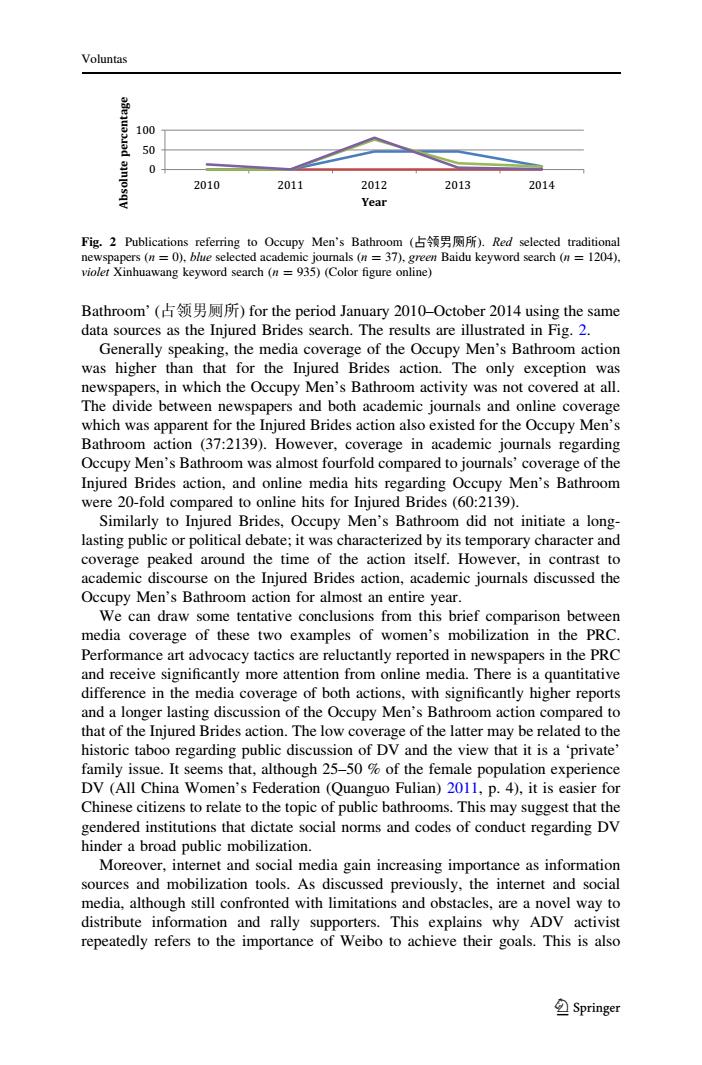正在加载图片...

Voluntas 100 50 0 2010 2011 2012 2013 2014 Year Fig.2 Publications referring to Occupy Men's Bathroom(占领男网所).Red selected traditional newspapers (n=0).blue selected academic joumals(n =37).green Baidu keyword search (n=1204). violet Xinhuawang keyword search (n=935)(Color figure online) Bathroom'(占领男厕所)for the period January20l0-October2014 using the same data sources as the Injured Brides search.The results are illustrated in Fig.2. Generally speaking,the media coverage of the Occupy Men's Bathroom action was higher than that for the Injured Brides action.The only exception was newspapers,in which the Occupy Men's Bathroom activity was not covered at all. The divide between newspapers and both academic journals and online coverage which was apparent for the Injured Brides action also existed for the Occupy Men's Bathroom action (37:2139).However,coverage in academic journals regarding Occupy Men's Bathroom was almost fourfold compared to journals'coverage of the Injured Brides action,and online media hits regarding Occupy Men's Bathroom were 20-fold compared to online hits for Injured Brides (60:2139) Similarly to Injured Brides,Occupy Men's Bathroom did not initiate a long- lasting public or political debate;it was characterized by its temporary character and coverage peaked around the time of the action itself.However,in contrast to academic discourse on the Injured Brides action,academic journals discussed the Occupy Men's Bathroom action for almost an entire year. We can draw some tentative conclusions from this brief comparison between media coverage of these two examples of women's mobilization in the PRC. Performance art advocacy tactics are reluctantly reported in newspapers in the PRC and receive significantly more attention from online media.There is a quantitative difference in the media coverage of both actions,with significantly higher reports and a longer lasting discussion of the Occupy Men's Bathroom action compared to that of the Injured Brides action.The low coverage of the latter may be related to the historic taboo regarding public discussion of DV and the view that it is a 'private' family issue.It seems that,although 25-50%of the female population experience DV(All China Women's Federation (Quanguo Fulian)2011,p.4),it is easier for Chinese citizens to relate to the topic of public bathrooms.This may suggest that the gendered institutions that dictate social norms and codes of conduct regarding DV hinder a broad public mobilization. Moreover,internet and social media gain increasing importance as information sources and mobilization tools.As discussed previously,the internet and social media,although still confronted with limitations and obstacles,are a novel way to distribute information and rally supporters.This explains why ADV activist repeatedly refers to the importance of Weibo to achieve their goals.This is also ②SpringerBathroom’ (占领男厕所) for the period January 2010–October 2014 using the same data sources as the Injured Brides search. The results are illustrated in Fig. 2. Generally speaking, the media coverage of the Occupy Men’s Bathroom action was higher than that for the Injured Brides action. The only exception was newspapers, in which the Occupy Men’s Bathroom activity was not covered at all. The divide between newspapers and both academic journals and online coverage which was apparent for the Injured Brides action also existed for the Occupy Men’s Bathroom action (37:2139). However, coverage in academic journals regarding Occupy Men’s Bathroom was almost fourfold compared to journals’ coverage of the Injured Brides action, and online media hits regarding Occupy Men’s Bathroom were 20-fold compared to online hits for Injured Brides (60:2139). Similarly to Injured Brides, Occupy Men’s Bathroom did not initiate a longlasting public or political debate; it was characterized by its temporary character and coverage peaked around the time of the action itself. However, in contrast to academic discourse on the Injured Brides action, academic journals discussed the Occupy Men’s Bathroom action for almost an entire year. We can draw some tentative conclusions from this brief comparison between media coverage of these two examples of women’s mobilization in the PRC. Performance art advocacy tactics are reluctantly reported in newspapers in the PRC and receive significantly more attention from online media. There is a quantitative difference in the media coverage of both actions, with significantly higher reports and a longer lasting discussion of the Occupy Men’s Bathroom action compared to that of the Injured Brides action. The low coverage of the latter may be related to the historic taboo regarding public discussion of DV and the view that it is a ‘private’ family issue. It seems that, although 25–50 % of the female population experience DV (All China Women’s Federation (Quanguo Fulian) 2011, p. 4), it is easier for Chinese citizens to relate to the topic of public bathrooms. This may suggest that the gendered institutions that dictate social norms and codes of conduct regarding DV hinder a broad public mobilization. Moreover, internet and social media gain increasing importance as information sources and mobilization tools. As discussed previously, the internet and social media, although still confronted with limitations and obstacles, are a novel way to distribute information and rally supporters. This explains why ADV activist repeatedly refers to the importance of Weibo to achieve their goals. This is also 0 50 100 2010 2011 2012 2013 2014 Absolute percentage Year Fig. 2 Publications referring to Occupy Men’s Bathroom (占领男厕所). Red selected traditional newspapers (n = 0), blue selected academic journals (n = 37), green Baidu keyword search (n = 1204), violet Xinhuawang keyword search (n = 935) (Color figure online) Voluntas 123